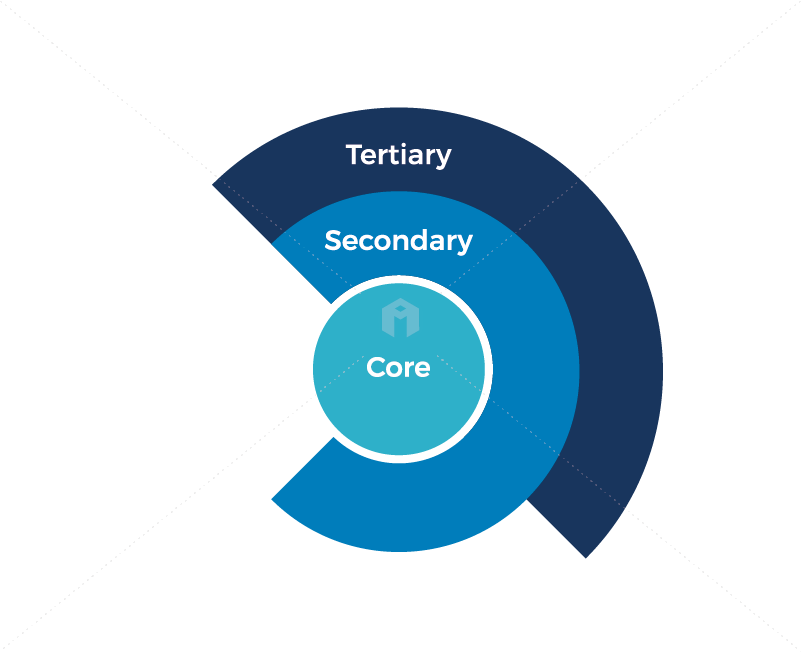Blog / Guest blog / PR Tips
How to use ‘Circles of Focus’ for a more targeted PR approach

A guest post written by Laura Hampton, Head of PR at Impression
It’s widely recognised that PR is a ‘top of the funnel’ activity as much as it is a conversion tool. In a less ‘business jargonny’ way, that, simply put, means it helps businesses reach new audiences. It grows visibility by making more people aware of a product, service or brand.
The scope for us as PR professionals is potentially limitless. ‘Spin’ the story in the right way or shoehorn ‘expertise’ into a client and we can get featured pretty much anywhere, for pretty much anything.
But while our counterparts of 20, even 10 – even 2! – years ago would have been judged on their ability to gain a high quantity of features, the modern PR (especially those working in the digital PR sphere) must focus on quality.
Why we aim for quality over quantity
PR, at its most basic level, is about getting the right messages out to the right people – right? We can all agree, then, that a feature that’s completely removed from our client in terms of its content or the publication in which it’s featured is going to be of less value than one in a highly revered publication for our target industry, where we’re positioned as experts or leaders.
The same is true of the way Google perceives the coverage we achieve. In the world of SEO (search engine optimisation – the process of improving visibility in the search results pages), coverage we achieve for our clients, when accompanied by links to our clients’ websites, count as votes. Websites with the most votes have a much better chance of featuring in the top spots of the search results pages.
But much like all coverage is not created equal, nor are links/votes. As far as Google is concerned (and therefore how your digital marketer type clients are going to judge you), coverage needs to be relevant to be worthwhile. Quality over quantity. Relevance over mass.
The ‘circles of focus’ theory
The circles of focus theory goes that you need to identify and agree the topics for which your client is willing to be known, and where they have credibility. The theory’s structure means that you also recognise the proximity of each topic to conversion – i.e. how likely the consumer of the content is to then decide to buy from your client (and how close to the bottom of the funnel your coverage sits).
Core topics
Core topics are those which sit at the heart of your strategy. They’re the topics that best represent your client’s primary offering(s).
Let’s say you have a client who sells fashion products online. Their core areas of focus might be ‘women’s clothing’ or ‘shoes’ or ‘jewellery’. Bag them a feature on Cosmopolitan or Harper’s Bazaar with an article talking about their latest range of women’s workwear and you’ll likely be rewarded with a very happy client. That’s because the idea of someone seeing that feature and going on to buy from your client is a pretty compelling one. The audience of that content likes fashion, your client is positioned as the fashion expert, and you’ve achieved the perfect mix.
From Google’s perspective, that works too. When it looks at who’s ‘voted’ for your fashion client in the form of a link to their site, the relevance of both the content and the publication will make this a much more valuable vote and contribute much more to improved search engine rankings.
Secondary topics
The thing about core topics is that they do sit closest to what your client sells. And they are, therefore, quite inherently, salesy. Journalists don’t want ‘salesy’ without good reason, so you can end up struggling to gain that coverage (unless you’re willing to pay for it which, for all sorts of reasons, won’t help your SEO visibility, but could still be worth doing in the right circumstances… but we digress).
That’s where we might start to move away from that core and consider the topics that are one step removed, where our client is willing to be known and still relevant, but not directly related to what they sell.
In the fashion client example, this might be topics around consumer engagement, retail, ecommerce or manufacturing. They might seek to be known as experts in merchandising or in sourcing ethical clothing or in the choice of fabrics. But at the same time, you’ll recognise that a feature on any one of those topics, while relevant, is less likely to prompt a conversion than your core topics.
Tertiary topics
These are the topics furthest removed from your core – but, importantly, still relevant.
Tertiary topics are usually the most mass in appeal, too. So while our fashion client might want to be known for their core topics more than any other, the scope for gaining them coverage when talking around tertiary themes like business growth, UK politics (careful here!) or zombie apocalypse plans (that’s right, we ran this campaign for a client) is much greater. That’s because there are more publications to talk about more general topics than there are fashion magazines.
Of course, the propensity of a consumer to buy your latest bomber jacket solely on the back of learning about your opinions on the best way to escape the undead is far less than that of someone who read your fashion article in Cosmo, so it’s about give and take – and the recognition that mass appeal is more about top of the funnel targeting and therefore can’t be judged on its ability to generate sales.
The circles of focus theory has been deftly visualised by the Impression design team, here:

Note the size of the circles – where the core is the smallest and the tertiary the largest, mirroring the potential target audience size for each.
How to agree circles of focus with a client (and how to use them in reality)
Theories are all well and good but if you don’t actually implement them, you won’t see the benefit.
Implementing a circles of focus approach has got to be a collaborative approach, and therein lies in beauty. Conducting a ‘focus workshop’ with your client might seem like a bit investment today, but get the topics pinned down early on and you stand a much better chance of pleasing them – and Google – in the future.
With topics agreed, it’s important to document them and ensure the information is shared with your whole team – internally and at the client end. That document becomes your agreement, firstly that you will actively seek opportunities in those topical areas and secondly that they will support your work by providing comment and content as required.
However you choose to go about implementing the circles of focus theory, the key takeaway is that it’s about relevance. There’s a lot of talk about ‘links’ in SEO and AVE in traditional PR, but it’s only when we consider the audience and the conversion funnel that we can truly show value in our work.
About the Author
 Laura Hampton is the Head of PR at multi award winning digital marketing agency Impression. With a background in journalism and PR alongside nearly 8 years in SEO, Laura works with her clients to craft digital PR campaigns that deliver tangible ROI. In her spare time, Laura represents the UK at international skydiving competitions with her team, Chimera.
Laura Hampton is the Head of PR at multi award winning digital marketing agency Impression. With a background in journalism and PR alongside nearly 8 years in SEO, Laura works with her clients to craft digital PR campaigns that deliver tangible ROI. In her spare time, Laura represents the UK at international skydiving competitions with her team, Chimera.
Follow Laura – @lauralhampton





